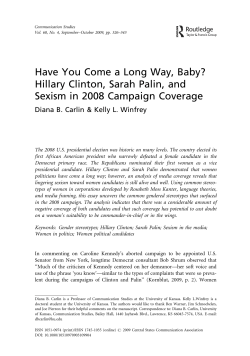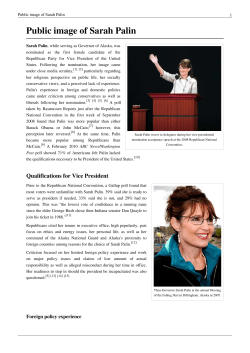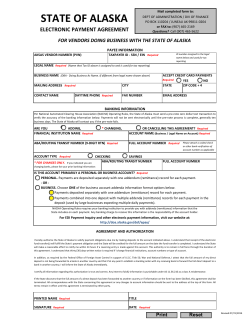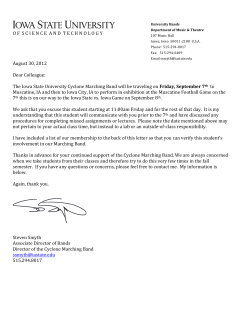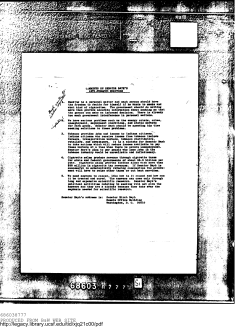
SARAH PALIN: A CONTEMPORARY WOMAN RHETOR
SARAH PALIN: A CONTEMPORARY WOMAN RHETOR A Rhetorical Analysis Written for the Partial Fulfillment of the Requirements of the Class CO 414 Rhetoric of American Women for Professor Anne Mattina Stonehill College By ANDREA GAGLIARDI December 15, 2009 Sarah Palin: A Contemporary Woman Rhetor, 2 Abstract: The 2008 Republican National Convention introduced the United States and the world to Governor Sarah Palin (R-AK), the newly nominated vice-presidential candidate running with Senator John McCain. Palin’s speech at the convention was a very effective display of contemporary women’s rhetoric. She had much to cover in the speech due to her relatively unknown status in the American political spectrum as well as her running mate’s recently low poll numbers. Her unique style included the use of humor, “folksiness” and feminine aspects which grabbed the attention of voters during the 2008 presidential election campaign, taking the attention away from Senator Barack Obama. This paper will take a detailed look at this rhetoric, breaking down the historical background and significance of the first national convention speech made by a woman Republican candidate for vice president. Sarah Palin: A Contemporary Woman Rhetor, 3 Introduction Sarah Palin (1964-) is an American woman from the state of Alaska. She was the first female mayor of her city, Wasilla. She then became the first woman governor of the state. She continued to make history by becoming the first Republican nominee for Vice-President of the United States of America, causing much excitement at the 2008 Republican National Convention. Her running mate was Senator John McCain and they were opposed by Senators Barack Obama and Joe Biden. This paper will be a rhetorical analysis of her speech at the convention. It will start with a brief biography of her life leading up to the nomination for Vice President. A background of the occasion for the speech will then be described. Next there will be a discussion of her rhetorical strategies. As a final point, a conclusion on the effectiveness of the speech will be determined. Biography Sarah Louise Heath was born on February 11, 1964 in Sandpoint, Idaho. At just two months of age, her family moved to Alaska, the 49th state. After living in various cities, the family finally settled in Wasilla. Sarah was the third of four Heath children. The family was very active, participating in all the outdoor activities the state had to offer. (Johnson, 2008). To discourage use of watching television and encourage spending time outdoors or with the family, the TV was kept in the garage, where it was freezing. However, Palin did admit to secretly watching Saturday Night Live, way after her bedtime (Palin, 2009). Little did she know that one day she would not only be portrayed on the show multiple times, but also be a guest on the show Sarah Palin: A Contemporary Woman Rhetor, 4 herself. Sarah was also a player on her high school women’s basketball team where she met Todd Palin, a senior transfer who was on the men’s basketball team (Palin, 2009). After high school, Todd and Sarah went their separate ways but found themselves back together again in Alaska during breaks from school. They eventually married after she finished college. Sarah started her education at the University of Hawaii. However, she decided that Hawaii was not the best environment for her academic goals. She then transferred to the University of Idaho and earned a bachelor’s of arts in Communications-Journalism in five years. She says that it took her longer to complete the degree because she paid for education herself and had to take semesters off in order to work (Palin, 2009). One way in which she earned money for college was to enter beauty pageants. In her memoir, Palin recalled an interview that took place as she was competing for the Miss Wasilla Scholarship: Judge: Geraldine Ferraro recently became the first female vice presidential candidate representing a major American political party. Do you think a woman can be vice president? Palin: Yes I believe a woman could be vice president. I believe a woman could be president. Judge: Would you vote for a vice presidential or presidential candidate just because she was a woman? Palin: No, I would not vote for someone just because they were a woman. I would vote for the candidate that reflected my political beliefs and had a strong character and family values. Sarah Palin: A Contemporary Woman Rhetor, 5 Judge: What do you think are Alaska’s best attributes? Palin: One of the best attributes of Alaska is its beauty, and everything that the great Alaska outdoors has to offer, from hunting and fishing to snowmachining/ (sic) in winter. And Alaska has amazing potential in drilling for oil on the North Slope. But unfortunately some Outsiders/(sic) don’t understand Alaska’s potential in developing our vast natural resources (Palin, 2009, p. 44). After viewing a video of this interview more than twenty-five years later, she said that these questions and answers could either be a strange coincidence or a “Providential signpost pointing toward my future.” (Palin, 2009, p. 44). She continued to write that she does not believe in coincidences (Palin, 2009). In 1996, twelve years after the Miss Wasilla interview, Palin went on to become the first female mayor of Wasilla. Then in 2002, she was approached by Senator Mike Murkowski to run as lieutenant governor- his running mate in the race for governor. Palin biographer, Joe Hilley writes that she wanted to help meet the serious challenges that Alaska faced, but that her experience seemed small and many people in the state believed that a woman’s place was in the home (Hilley, 2008). But Palin was not afraid of these challenges and she did run for lieutenant governor. However, Palin did not win the nomination for lieutenant governor. After Murkowski was elected, Palin was appointed to the Alaska Oil and Gas Conservation Commission. The position gave her much economic and environmental experience, but it did not increase her reputation as a public speaker. Again, not to be torn down by the skeptics who did not feel she was qualified, or that she would be too burdened to raise four Sarah Palin: A Contemporary Woman Rhetor, 6 children and run the biggest state in the country, Palin went on to run for the governor of Alaska. In 2006, she was elected to be the first female governor of Alaska, less then fifty years after Alaska became a state (Hilley, 2008). In 2007, Palin was featured in Newsweek to represent women governors. She was only one of twenty-nine in the history of the country. At this point, no one knew that that she would soon leave the confines of Alaska and would become part of the national political spectrum. Newsweek wrote, “While this year’s political buzz has been around Hillary Clinton’s run for the White House and Nancy Pelosi’s ascension to Speaker of the House, women leaders like Palin, a Republican and Janet Napilatano (Arizona), a democrat have gained significant power in the lives of millions of Americans at the state level.” (Breslau, 2007, p. 1). The article continued to say, “It is no coincidence that two of the nation’s most popular women governors come from frontier states (Arizona and Alaska are the 48th and 49th state respectively to join the Union) without established social orders that tend to block women from power.” (Breslau, 2007, p. 5) Growing up in a frontier state where she ultimately rose to the state’s highest political position, the first woman to do so, may have given Palin the confidence she needed to say yes, when Senator John McCain called her at the Alaska State Fair and asked her if she wanted to help him change history (Palin, 2009). On August 29, 2008, Senator John McCain of Arizona, the Republican nominee for President of the United States announced his pick for a running mate. The announcement was said to be, “vintage John McCain- daring, unconventional and totally unexpected.” (James, 2008, p.7) Other scholars have said that McCain’s selection was a “calculated risk, a tactical move designed to attract the votes of women who may have first been disaffected by Hillary Clinton’s loss of the Sarah Palin: A Contemporary Woman Rhetor, 7 presidential nomination and second by her exclusion from the Obama ticket.” (Kahl and Edwards, 2009, p 268). For the first time in the history of the Republican Party, and only the second time in the history of the United States, he picked a woman. Virtually unknown outside of Alaska, Sarah Palin would become one of the most recognizable names in the country. While she had strong rhetorical talent, she only spoke to the national media on rare occasions during the campaign (Edwards, 2009). Her first major appearance would take place on September 3rd at the Republican National Convention in Saint Paul, Minnesota, where she accepted the nomination five days after John McCain’s announcement. Her speech would become iconic, qualifying as a “Representative American Speech” for the 2007-2008 time period (Boucher, 2008). Background of the Speech Palin said that writing her convention speech was a team effort, and the captain of the team was Matthew Scully, who had previously written speeches for President George W. Bush, Vice President Dick Cheney and Senator John McCain. While Scully wrote the speech, Palin said that he was, “very generous about letting me add my own words.” (Palin, 2009, p. 240) In her memoir, Going Rogue: An American Life , Palin wrote that she practiced for hours with the teleprompter. She said that she found this “peculiar”, because in the past if she knew her speech, she used notes, and if she didn’t, she used a teleprompter (Palin, 2009, p. 240). All this practice turned out to be very beneficial to Palin, because not even halfway through the speech, the teleprompter broke. Palin wrote, “I knew the speech well enough that I didn’t need it, which was a good thing, since the machine didn’t sync up for the remainder of my time on stage.” (Palin, 2009, p. 240) In addition to the teleprompter failing, Palin wrote that she was able to stay Sarah Palin: A Contemporary Woman Rhetor, 8 grounded during the speech because the last thing she did before going on stage was change her son’s diaper (Palin, 2009). The main purpose of the speech was to rally support for Senator John McCain, but because she was new to the national field, Palin had to introduce herself to the country as well. Palin had to address the major issues of the presidential campaign, how John McCain felt about these issues and also show how she fit into the puzzle. Palin’s main disadvantage during this speech was that the audience did not know much about her since she was only nominated five days earlier. However, this could also have been seen as a positive because the audience was very open minded and supportive of McCain’s non-conventional nomination. Rhetorical Analysis There were two sets of audiences for this speech: the people who were inside the convention center, and the millions of Americans watching at home. Palin had to make sure that she addressed both of these people. The audience at the convention was very supportive of Palin. They continually interrupted her speech with applause as well as laughing and chanting. These were not people that Palin needed to convince to vote for McCain. For this audience, Palin only needed to introduce herself and her family. She started to introduce her family by talking about her son Track who is a member of the Army and was about to be deployed to Iraq at the time of the speech. She was able to connect her experiences as an Army mom to the wars in Iraq and Afghanistan, as well as to Senator McCain, who is a former POW and Vietnam Veteran. She said, Sarah Palin: A Contemporary Woman Rhetor, 9 Our nominee for president is a true profile in courage, and people like that are hard to come by. He's a man who wore the uniform of his country for 22 years and refused to break faith with those troops in Iraq who now have brought victory within sight. (APPLAUSE) And as the mother of one of those troops, that is exactly the kind of man I want as commander-in-chief. (Palin, 2008) After introducing her three daughters (Bristol, Willow and Piper), Palin then brought the attention to her youngest child. Trig Palin was only a few months old when his mother was nominated for vice president. He was diagnosed with Down syndrome in-utero. Palin was able to connect her experience as the mother of a special needs child to her pro-life beliefs as well as her dedication to the advocacy of special needs. She then introduced her husband, Todd, a native Alaskan and blue collar worker for the Alaska Oil Company. He is also an avid sportsman. With her husband working on the oil fields and her former job as part of the Alaska Oil and Gas Conservation Commission, Palin was able to connect her family even more to the political issues of contemporary America. At this point, the teleprompter stopped working properly. However, Palin continued by concluding the family introductions by bringing the attention to her parents Chuck and Sally Heath who both worked in an elementary school. Palin went on to say that one of the most important things her parents taught her was, “This is America and every woman can walk through every door of opportunity.” (Palin, 2008) Sarah Palin: A Contemporary Woman Rhetor, 10 In describing her family and how they relate to her political ideology, Palin is telling the audience that she is proof of what she is arguing in terms of the American dream. The American dream is a concept that was first devised by historian James Truslow Adams. Adams wrote that no theme was more important than what he called, the American dream of a better richer, happier, life for all our citizens of every rank, which is the greatest contribution we have made to the thought and welfare of the world. That dream or hope has been present from the start. Ever since we became an independent nation, each generation has seen an uprising of ordinary Americans to save the dream from the forces which appeared to be overwhelming it. (Cullen, 2003, p. 4) In her speech, Sarah Palin is showing that she is the American dream. She is proof that women can do anything, including have their name on the presidential ballot, while raising a very diverse family of five children. Palin continued the speech by describing herself to the audience as an average hockey mom. Seeing a group of hockey moms in the audience, Palin inserted an impromptu joke in her speech (Palin, 2009). She said, “I love those hockey moms. You know they say the difference between a hockey mom and a pit bull? Lipstick.” (Palin, 2008) This saying immediately took off and became associated with Palin. Donny Deutch of CNBC praised her rhetorical style saying, “She’s a lioness. Look, she gave you the brand icon logo, the pit-bull with lipstick. Who wouldn’t want a lioness protecting their cubs? She’s funny, she’s real, she’s rock solid, she’s feisty, she’s smart. If I need to sell Woman in Power to the American public that’s what I’m putting into my cereal.” (Carlin & Winfrey, 2009, p. 338) However, the association wasn’t Sarah Palin: A Contemporary Woman Rhetor, 11 always positive and Senator Obama said, “You can put lipstick on a pig and it’s still a pig.” (Campaigns Joust, 2008. p. 1). In the next section of her speech, Palin told the audience how she progressed from hockey mom to a member of the PTA to the Mayor of Wasilla to the Governor of Alaska. Telling the story of her family and her progression allowed her to complete the goals that were necessary for her to rally support from those attending the convention. This again brings back Adam’s theme of the American dream and opportunity for all. Palin had been able to continually make progress through her life, reaching higher and higher rankings in the political spectrum. She was very successful and seemed to be able to accomplish anything she set her mind to. Her life wasn’t perfect, she didn’t earn a college degree in four years nor did she win the lieutenant governor nomination in 1992. She had family difficulties too, with a special needs baby, an unmarried pregnant teenage daughter, and a son whom she would be worrying about as he began his deployment. But, she was able to show that she is a real person who can get past these obstacles and do things that have never been done before. She is the American dream and she was able to get the crowd to believe that. However, the television audience was made up of Democrats, Republicans and Independents. Independents are usually the people who decide elections, because the Republicans will always vote for the Republicans and the Democrats will always vote for the Democrats (Perry, 2009). To this audience, Palin needed to prove that John McCain was the candidate for them and that she was qualified to work alongside him. Sarah Palin: A Contemporary Woman Rhetor, 12 There were many questions about her ability to balance being vice president with her family of five children including a special needs baby and a pregnant teenage daughter. These skepticisms show that in our culture, there are still stereotypical beliefs regarding women’s domestic roles as impediments to active public life (Kahl and Edwards, 2009) This was a major constraint for Palin that she had to address head on. However, in the past women who were public figures, “argued that they were in a unique position to care for society because of their feminine virtues, including the feminine ability to be a mother.” (Atkins-Sayre, 2009, p. 130). In her article Governor Mom, Wendy Atkins-Sayre writes that this strategy was ultimately criticized as, “ ‘reductive and essentialist’ and ultimately a step backward for women.” (Atkins-Sayre, 2009, p. 130) Christina Henry de Tessan, an Obama supporter and mother of two said, “You can juggle a Blackberry and a breast pump in a lot of other jobs but not in the vicepresidency.” (Carlin and Winfrey, 2009, p. 333) Even Republicans had their doubts, such as Anne Faircloth, the daughter of former Senator Lauch Faircloth of North Carolina. She said, “Being a governor is one thing and Ms. Palin’s husband, Todd, seems like a supportive spouse, but running for the second highest office in the land is a very different kettle of fish.” (Carlin and Winfrey, 2009, p. 333) Palin counteracted these types of arguments in her speech by relating the variety of people in her family into political issues such as special needs awareness, support of the armed forces, environmental concerns and the economy for average working class people. This is a strategy known as enactment, where the speaker herself is proof of the argument she is making. This is a type of feminine style that allows the speaker to give proof of the claim she is making and a way to present evidence vividly. (Mattina, 1994) Palin uses enactment to show that not Sarah Palin: A Contemporary Woman Rhetor, 13 only does she have political beliefs, she is her political ideology. She is part of a working class family. She is an Army-mom. She is an environmentalist. Her speech addressed these issues head on and also was very personal in tone, another aspect of feminine rhetorical style (Cambpell, 1989). Some examples of the use of this style are: To the families of special-needs children all across this country, I have a message for you: For years, you've sought to make America a more welcoming place for your sons and daughters. And I pledge to you that, if we're elected, you will have a friend and advocate in the White House (Palin, 2008). And No one expects us all to agree on everything, but we are expected to govern with integrity, and goodwill, and clear convictions, and a servant's heart. And I pledge to all Americans that I will carry myself in this spirit as vice president of the United States. (APPLAUSE) This was the spirit that brought me to the governor's office when I took on the old politics as usual in Juneau, when I stood up to the special interests, and the lobbyists, and the Big Oil companies, and the good-old boys. Using terms such as “the good-old boys” gives her rhetorical style a folksy and humorous aspect. Other examples of such expressions include: And two decades and five children later, he’s still my guy. But-- now here’s a little newsflash. Sarah Palin: A Contemporary Woman Rhetor, 14 And I thought we could muddle through without the governor’s personal chef, although I got to admit that sometimes my kids sure miss her. And take is from a gal who knows the North Slope of Alaska: We’ve got lots of both (oil and gas). Clearly what the majority leader was driving at is that he can’t stand up to John McCain and that is only…(applause)…That is only one more reason to take the Maverick out of the Senate and put him in the White House. Utilizing such a rhetorical style also allows her to really connect with the audience. Susan Geary of Virginia said that, “We feel like she talks like we do, like she’s sitting in your kitchen.” (Copeland, 2008, p. 2) Washington Post Staff Writer, Libby Copeland writes that Palin’s delivery allows her to leap through the camera and into your living room. Republican strategist Ron Bonjean agreed with Copeland saying, “The camera will steal your emotions and make you flat, and what she’s doing is over emphasizing her emotions, over emphasizing her delivery, in order to get that realness across to the camera.” (Copeland, 2008, p. 2) Copeland continues to write, “There is a consistency to Palin’s appeal—if you go back and look at old clips of her, you see many of the same stylistic elements—the warmth and eager delivery, the voice that drops and rises emphatically, the dropped g’s.” (Copeland, 2008, p. 2) The article goes on to quote an Anchorage-based pollster who said that, “Her success in her political career has been based on being able to project this enormously friendly, enormously appealing physical presence.” (Copeland, 2008, p. 2) Sarah Palin: A Contemporary Woman Rhetor, 15 But as mentioned earlier, defending her experience, qualifications and readiness to take on the second highest position in the country (as well as charming the audience) was not Palin’s only objective of the speech. She also had to convince the audience to vote for Senator McCain. For the first half of her speech, Palin concentrates almost solely on her life and her accomplishments. From time to time she interjected some information about Senator McCain. An example of this is: I came to office promising to control spending, by request if possible, but by veto, if necessary. (APPLAUSE) Senator McCain also -- he promises to use the power of veto in defense of the public interest. And as a chief executive, I can assure you it works. (APPLAUSE) Our state budget is under control. We have a surplus. And I have protected the taxpayers by vetoing wasteful spending, nearly $500 million in vetoes. (Palin, 2008) As the speech continued, Palin then took on the task of specifically addressing the opposing presidential candidate, Senator Barack Obama. She spent some time talking about him when she was about one-third through her speech, but then switched back to talking about herself again. Using this style of constantly switching the gears of the speech was likely designed to keep the audience’s attention. If she only talked about herself, they would get bored, and if she Sarah Palin: A Contemporary Woman Rhetor, 16 only talked about how great McCain was, they would get bored as well. By talking about these topics as well as addressing the rival candidate, Palin was likely able to keep the attention of the audience. She went back to the topic of Senator Obama again at about the two –thirds point. She spent approximately five minutes deconstructing Obama’s experiences and views, in the hope to persuade the audience that Obama was not the candidate they wanted in the White House. She even addressed Obama’s rhetorical skills saying: This is a man who can give an entire speech about the wars America is fighting and never use the word "victory," except when he's talking about his own campaign. (APPLAUSE) But when the cloud of rhetoric has passed, when the roar of the crowd fades away, when the stadium lights go out, and those Styrofoam Greek columns are hauled back to some studio lot... (APPLAUSE) ... when that happens, what exactly is our opponent's plan? What does he actually seek to accomplish after he's done turning back the waters and healing the planet? (Palin, 2008) Palin concluded her speech by talking about Senator John McCain. She was able to smoothly switch gears from criticizing Obama to praising McCain, by indirectly referencing Obama’s slogan, “Change We Can Believe In” as well as McCain’s slogan, “Country First”. She said, Sarah Palin: A Contemporary Woman Rhetor, 17 Here's how I look at the choice Americans face in this election: In politics, there are some candidates who use change to promote their careers, and then there are those, like John McCain, who use their careers to promote change. …Our nominee doesn't run with the Washington herd. He's a man who's there to serve his country and not just his party, a leader who's not looking for a fight, but sure isn't afraid of one, either. (Palin, 2008) She then went on to talk about Senator McCain’s military experiences and Senator Obama’s lack thereof saying, “There is only one man in this election who has ever really fought for you.” (Palin, 2008) Palin wrote that the hardest part of giving this speech was talking about John McCain’s experience in a POW camp, especially the section about a name named Tom Moe, who was a prisoner with McCain. She wrote, “During rehearsal, there was one part of the speech I thought I might not make it through gracefully…so during the live speech, I planned to just pinch myself, and grit my teeth when I came to that part.” (Palin, 2009, p. 240) She said that as she got to that part of the speech, her throat tightened but she was able to pause and brace herself due to a thundering applause (Palin, 2009). When she started the section with the words, “A fellow-a fellow prisoner of war, a man named Tom Moe of Lancaster Ohio” (Palin 2008), the applause grew even louder and she noticed a commotion in the front row. A group of people were pointing to a man while clapping and patting him on the back. He had tears in his eyes, and at this point, Palin did too. She wrote that she could make out what they were saying: “He’s here! This is Tom Moe!” (Palin, 2009, p. 244). She blew him a kiss and continued. She writes that at that point, “I knew it would only be by the grace of God that I would make it through the next part of our message because words in a speech don’t do our veterans justice.” (Palin, 2009, p. 245) She continues to write, Sarah Palin: A Contemporary Woman Rhetor, 18 Seeing Tom Moe standing there made our message about national greatness so real. This wasn’t campaign hype. Here was an authentic American hero standing right in front of me. I’d had no idea he was going to be there. It was an honor to be in his presence. I’m not sure how the next lines flowed because I was so overwhelmed with American pride that the rest of the speech was a blur. (Palin, 2009, p. 245) This reflection portrays how real and genuine Sarah Palin considers herself. She truly believed in what she was telling the crowd that night. She wrapped up her speech saying, If character is the measure in this election, and hope the theme, and change the goal we share, then I ask you to join our cause. Join our cause and help America elect a great man as the next president of the United States. (Palin, 2008) By ending the speech with the focus on McCain, Palin reminded the audience why they were listening to her in the first place. The audience is listening to this speech by Palin, because she was chosen to be the running mate of John McCain. In the end, it would be McCain’s name on the top of the ballot with Palin’s name underneath. Her ultimate purpose in this speech was to convince the voters that John McCain was the candidate for them. Conclusion There are many ways in which the effectiveness of Palin’s speech can be determined including the reactions from the audience, journalists and political experts, as well as poll results. The audience was extremely active through her speech. Based on a transcript provided by The New York Times, during her speech which lasted 36 minutes and 31 seconds, the audience broke Sarah Palin: A Contemporary Woman Rhetor, 19 into applause 65 times. There are also instances where Palin had to stop due to audience laughter or chanting phrases such as “USA! USA! USA!” and “Drill, baby drill! Drill, baby drill!” Due to this reaction, it can be determined that the audience in the convention center found her speech to be very effective. But as discussed in the rhetorical analysis section of this paper, Palin also needed to speak to the video camera in order to rally the audience at home. The effect on this audience can be determined through poll numbers. On September 8, 2009, Gallup, a company that performs public opinion polls headlined, “Republican Enthusiasm Jumps After Convention: McCain edges ahead: Palin Speech may be factor”. (Newport, 2008, p. 1) The Gallup poll found that: The presidential race was dead even at 45% to 45% among registered voters in Gallup tracking conducted prior to the Democratic convention. Then, by the USA Today/Gallup Poll conducted in the first few days after the Democratic convention (and also after McCain had made his announcement of Sarah Palin as his running mate), Obama had moved ahead by a 47% to 43% margin. (In Gallup Poll Daily tracking extending into the beginning of last week, Obama reached a point where he had 50% of the vote and an eight percentage point lead.) Obama's lead has now disappeared totally, and McCain sits on a 4-point advantage among registered voters in the Friday through Sunday poll. That's the largest advantage for McCain in either USA Today/Gallup Polls or Gallup Poll Daily tracking since May. (Newport, 2008, p. 2) The poll also found that more Republicans had greater enthusiasm about the election now than they had before the convention. Enthusiasm jumped from 42% one week before the Republican National Convention ( but after the Democratic National Convention), to 60% after the Sarah Palin: A Contemporary Woman Rhetor, 20 Republican National Convention. Of course, Palin’s speech cannot be seen as the only factor in the Republican rise in polls, but it was certainly an aspect that needs to be taken into high account. To further study the effectiveness of Palin’s speech, Gallup also conducted a poll in which participants were asked to rate the speech given five choices: excellent, good, just OK, poor and terrible. The results are as follows: 42% said that her speech was excellent; 18% said that her speech was good; 14% said that it was just OK; 7% said it was poor; and 7% said it was terrible. (Newport, 2008, p. 5) With sixty percent of those polled saying that her speech was in the higher two of the five categories, it can be held that the effectiveness was high. These polls numbers could have been even higher if political bias was taken into account and the speech was judged solely on its rhetorical value. Newscasters also had a lot to say about Palin’s speech at the Republican National Convention. Both Chris Wallace of FOX News and Wolf Blitzer of CNN said, “A star is born.” (James, 2008, p. 26) Blitzer also said, “It wasn’t just a home run, it may have been a grand slam.” (James, 2008, p. 27) Political experts pointed out that this was not the first time that a national convention brought light to a new and rising star. Barack Obama was thrust into the spotlight for the first time as a speaker at the 2004 Democratic National Convention. However, it was also pointed out that, “while the speech was a homerun, it was still the first inning.” (James, 2008, p. 27) Indeed Palin’s speech could be considered a homerun in the first inning of a marathon baseball game. In the end, the Obama-Biden campaign would be able to take back the lead that the McCain-Palin campaign gained from the convention. However, despite the fact that McCainPalin won the convention battle, but not the election war, the success of her speech at the Sarah Palin: A Contemporary Woman Rhetor, 21 convention cannot be undermined. The polls as well as the audience, political expert and journalistic reactions prove that this was a very effective attempt of political rhetoric. Sarah Palin: A Contemporary Woman Rhetor, 22 Works Cited Atkins-Sayre, Wendy. Governor mom: Jane Swift and the body politic. Janis L. Edwards (Ed.) Gender and Political Communication in America (pp. 129-148). Lanham, MD: The Rowman & Littlefield Publishing Group, Inc. Boucher, Brian (Ed.) (2008). Representative American Speeches 2007-2008. New York: H. Wilson Inc. Breslau, Karen. (2007, October 15). Now This is Woman’s Work. Newsweek http://www.newsweek.com/id/42534/page/ Campaigns joust over Obama's 'pig' remark. (2008, September 10). The New York Times http://www.nytimes.com/2008/09/10/world/americas/10iht-pig.1.16033771.html Campell, Karyln Kohrs (1989). Man Cannot Speak For Her. West Port, CT: Prager Publishers. Carlin, Diana B. & Winfrey, Kelly L (2009). Have you come a long way baby?: Hillary Clinton, Sarah Palin, and Sexism in 2008 Campaign Coverage. Communications Studies 60(4), 326-343. Copeland, Libby (2008, October 1). Shooting from the hip, with a smile to boot. The Washington Post. http://www.washingtonpost.com/wp-srv/artsandliving/stylefeatures/2008/rhetoric/ gallery.html Cullen, Jim (2003). The American Dream: A Short History of the Idea that Shaped a Nation. New York: Oxford University Press. Hilley, Joe (2008). Sarah Palin: A New Kind of Leader. Grand Rapids, MI: Zondervan. James, G. Robert (2008). Sarah Palin: The Real Deal. Lakeland, Fl: Whitestone Books. Johnson, Kaylene (2008). Sarah: How a Hockey Mom Turned the Political Establishment Upside Down. Carol Stream, IL: Tyndale House Publishing. Kalh, M. and Edwards, J. (2009). Learning from Sarah Palin’s vice presidential campaign. Janis L. Edwards (Ed.) Gender and Political Communication in America (pp. 267-277). Lanham, MD: The Rowman & Littlefield Publishing Group, Inc. Mattina, Anne F. (1994). “Rights as Well as Duties”: The rhetoric of Leonora O’Reilly. Communication Quarterly 42(2), 196-205. Newport, Frank (2008, September 8). Republicans enthusiasm jumps after convention. Gallup/USA Today Sarah Palin: A Contemporary Woman Rhetor, 23 http://www.gallup.com/poll/110107/republicans-enthusiasm-jumps-after-convention.aspx Palin, Sarah (2009). Going Rogue: An American Life. New York: Harper Collins Publishers. Palin, Sarah (2008, September 3). Palin’s Speech at the Republican National Convention http://elections.nytimes.com/2008/president/conventions/videos/transcripts/200809 03_PALIN_SPEECH.html Perry, Jeffrey Davis (2009). My GOP. Sandwich, MA: Perry Books.
© Copyright 2025

